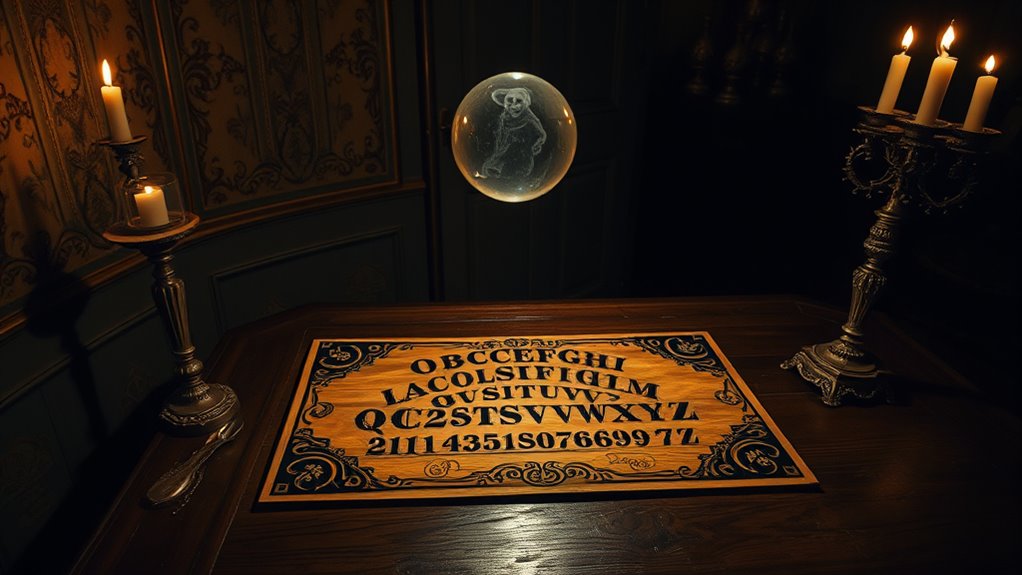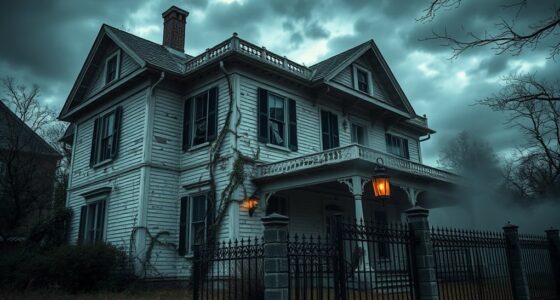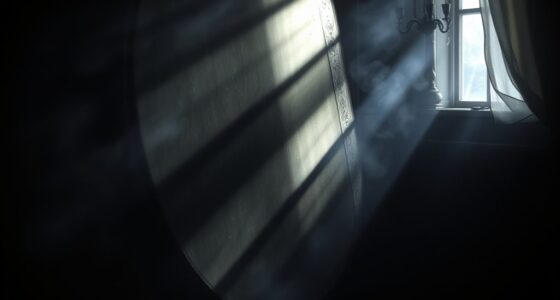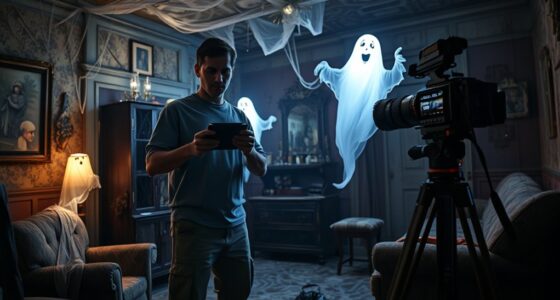Many believe that Ouija boards are always dangerous gateways to evil, but that’s a myth. In reality, their risks come from cultural fears, media portrayals, and psychological effects like the ideomotor response. Most users find the boards harmless if approached responsibly. Understanding the history and psychological factors helps you see that they’re not inherently evil. If you want to uncover more about what’s real versus myth, there’s a lot to explore below.
Key Takeaways
- Cultural fears and media portrayals exaggerate the dangers, but scientific evidence shows no inherent risk in using Ouija boards.
- Many experiences with Ouija boards are subconscious reflections or effects of expectations, not supernatural contact.
- Proper understanding and cautious use can prevent negative experiences; they are not automatically portals to evil.
- Historically, Ouija boards started as a game, with fears developing over time through stories and sensationalism.
- Personal mindset and intentions influence outcomes; they are tools, not inherently dangerous or evil devices.

Many people believe that using a Ouija board inevitably invites danger and supernatural trouble. This perception isn’t new; it’s rooted in both history and cultural perceptions that have shaped how we view these mystical tools. The origins of the Ouija board date back to the late 19th century, during a time when spiritualism was gaining popularity. It was initially marketed as a fun parlor game, but many believed it had the power to contact spirits. Over time, stories of accidents, hauntings, and malevolent spirits linked to Ouija boards fueled fears that they could open doorways to dangerous realms. These stories reinforced the idea that, beyond mere entertainment, Ouija boards are gateways to chaos and evil.
Culturally, perceptions of Ouija boards have been influenced by movies, books, and religious teachings that warn against dabbling in the supernatural. Hollywood, in particular, has depicted them as instruments for summoning spirits or unleashing curses, reinforcing the idea that they’re inherently dangerous. Many religious groups have condemned their use, claiming they invite demonic entities or invite spirits that can’t be controlled. These portrayals create a sense of dread whenever someone mentions using a Ouija board, making it seem like a risky gamble with supernatural consequences. As a result, many people shy away from even considering its use, fearing dire repercussions.
However, when you look at the historical origins, the picture isn’t so black and white. While some early stories include negative experiences, many users have found the boards to be harmless or simply a reflection of the subconscious mind. The popular perception of danger often stems from sensationalized stories and cultural conditioning rather than concrete evidence. In fact, psychological factors like the ideomotor effect—where your subconscious influences movements—explain much of the activity during a session. This suggests that, with proper caution and understanding, using a Ouija board doesn’t necessarily invite supernatural harm. Additionally, scientific research into psychological explanations has provided insights into how beliefs and expectations shape experiences.
Despite these insights, cultural perceptions still cast a long shadow. Fear and superstition continue to influence how people view Ouija boards, often exaggerating their risks. The media’s portrayal of them as dangerous tools ensures that many associate their use with evil or disaster. But the reality is more nuanced. It’s up to you to decide whether the board is a harmless game or a dangerous portal. Knowing its history and understanding how cultural perceptions shape our beliefs can help you approach the subject with skepticism rather than fear. The truth lies somewhere in the middle—Ouija boards aren’t inherently evil, but your mindset and intentions can influence your experience.
Frequently Asked Questions
Can Ouija Boards Be Used Safely Without Negative Effects?
You can use a Ouija board safely if you prioritize spiritual safety and protect your mental health. Set clear intentions, remain calm, and avoid questions that could stir negative energy. Always approach it with respect and skepticism, and stop if you feel uncomfortable. Remember, maintaining a positive mindset and grounding yourself can help prevent negative effects, making your experience safer and more controlled.
Are There Historical Instances of Ouija Boards Causing Harm?
You might think Ouija boards are just games, but historical incidents show they can sometimes lead to spiritual harm. These stories act as warnings, like a shadow lurking behind a flickering candle, reminding you that some interactions with the unknown can backfire. While many use them harmlessly, it is crucial to respect their power, knowing that in rare cases, they’ve caused real distress and spiritual consequences.
Do Professional Mediums Recommend Using Ouija Boards?
Professional mediums generally don’t recommend using Ouija boards, as they often approach them with skepticism and caution. They believe these boards can interfere with genuine spiritual guidance and might invite unwanted energies. If you’re seeking spiritual insight, it’s better to consult a trusted medium directly, rather than relying on a Ouija board, which can sometimes lead to confusion or negative experiences. Always prioritize safety and clarity in spiritual practices.
How Can Users Protect Themselves When Using a Ouija Board?
To protect yourself when using a Ouija board, take user precautions like setting clear intentions and remaining calm. Use protective measures such as calling on positive energies or guides before starting. Keep the session focused, avoid asking personal or negative questions, and always close the board properly afterward. Trust your intuition, stay grounded, and remember that your mindset greatly influences the experience. These steps help minimize risks and promote a safer session.
Are Certain Types of Ouija Boards More Dangerous Than Others?
Certain types of ouija boards, like those made from cheap, flimsy materials or with elaborate, unsettling designs, can be more dangerous. For example, a board with intricate, eerie imagery might heighten emotional responses. The material and design variations influence your experience; sturdy, well-crafted boards tend to be safer. Always choose a reputable, high-quality board to minimize risks and focus on safe practices during use.
Conclusion
So, next time you sit down with a Ouija board, remember—you might just be opening a door to adventure, not necessarily danger. Ironically, what’s often feared as a portal to evil can turn into a harmless game or even a source of insight. Instead of inviting spirits, you might just find yourself inviting curiosity and a little harmless fun. Sometimes, the real danger is in believing all the hype—because not every shadow hides a ghost.









